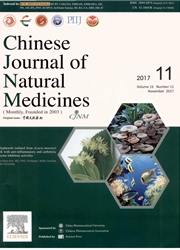

 中文摘要:
中文摘要:
目的:建立快速、灵敏和选择性的测定葡萄糖醛酸转移酶(UGT)1A9活性的超高效液相色谱电喷雾质谱联用(UPLC—ESI—MS)分析方法,研究不同种属uGT1A9活性差异。方法:选用AcquityUPLCBEHC18柱(50mm×2.1mm,1.7μm),以乙腈(B)-0.5%醋酸(A)系统为流动相,流速0.3mL·min-1梯度洗脱,采用UPLC-MS—ESI选择离子监测法测定人及动物肝微粒体孵育体系中UGT1A9探针底物异丙酚及其Ⅱ相代谢产物异丙酚葡萄糖醛酸苷(propofol glucuronide,PG)和内标(对乙酰氨基酚)的浓度,测定UGTlA9的活性。内标,异丙酚及PG的选择离子分别是:m/z152.2.[M+H]+、m/z177.3和m/z377.3,【M+Na]+。结果:肝微粒体孵育体系中PG浓度在0.2—12.8μg 2·mL-1范围内呈良好线性,日内和日间精密度(RSD)小于3%,准确度(RME)在-3.46%.3.03%之间,回收率为96.5%-98.6%。UGT1A9活性的种属差异研究结果表明,异丙酚在人、小鼠、家兔和羊肝微粒体孵育体系中的葡萄苷酸化反应动力学表现为底物抑制方程,而在大鼠肝微粒体孵育体系中的酶催化动力学符合米曼氏动力学方程。异丙酚在不同种属肝微粒体中的。一葡萄苷酸化的内在清除率(CLint)大小为小鼠〉大鼠(CLint1+CLint2)〉羊〉家免〉人〉大鼠。结论:UPLC—MS—ESI法快速、灵敏、选择性好.UGTIA9活性和种属差异研究表明,大鼠肝微粒体中异丙酚葡萄糖醛酸化反应的动力学模式与人不同,而小鼠、兔、羊肝微粒体中异丙酚葡萄糖醛酸化反应的内在清除率均远高于人。
 英文摘要:
英文摘要:
AIM: To establish a UPLC-ESI-MS method for the assay of UDP-glucuronosyltransferases(UGT) 1A9 activities in human and animal liver microsomes, to investigate the interspecific differences of UGT1A9. METHODS: The probe substrate of propofol (mlz 177.3), Ⅱ phase metabolite of propofol glucuronide (PG) (ndz 377.3, [M + Na]+), and internal standard (IS) of 3-acetamidophenol (m/z 152.2, [M + HI+) were quantified by selective ion monitor (SIM), using electrospray ionization-MS (ESI-MS), acquity UPLC BEH Ciscolumn (50 mm × 2.1 mm, 1.7 μm) and a mixture of acetonitrile(B)-0.5% acetic acid(A) as flow phase in gradient elution at flow rate of 0.3 mL-min i. RESULTS: The linearity was within 0.2 to 12.8 kμ.mL-1 for P(2 The intra- and inter-day precisions were less than 3% and the accuracies ranged from -3.46% to 3.03%. The recoveries of PG from human liver microsomes (HLMs) were 96.5%-98.6%. The method was successfully used to determine the kinetics of propofol glucuronidation in human and different animals liver microsomes. The results indicated that the kinetics of propofol O-glucuronidation in liver micro- somes from human, mouse, rabbit and sheep were fitted to the substrate inhibition equation, whereas the kinetics in rat liver micro- somes was fitted to the two-enzyme Michaelis-Menten equation. The intrinsic clearance (CLint) of propofol glucuronidation in different liver microsomes was in the order of mice 〉 rats (CLint1 + CLint2)〉 sheep 〉 rabbits 〉 human. CONCLUSION: The method is rapid, sensitive and selective for assay of UGT1A9 activities in liver microsomes. The results indicated that the kinetics of propofol O-glucuronidation in rat liver microsomes is different from that in HLMs, and the CLint value for propofol O-glucuronidation in liver microsomes from mice, sheep, and rabbit are remarkably higher than that in HLMs. In animal experiments for drug development, these interspecific differences should be taken into considerat
 同期刊论文项目
同期刊论文项目
 同项目期刊论文
同项目期刊论文
 Interspecific Difference Assay of UDP-glucuronosyltransferase 1A 9 Activities in Liver Microsomes by
Interspecific Difference Assay of UDP-glucuronosyltransferase 1A 9 Activities in Liver Microsomes by Identification of the UGT isozyme involved in senecionine glucuronidation in human liver microsomes.
Identification of the UGT isozyme involved in senecionine glucuronidation in human liver microsomes. Involvement of Bcl-xL degradation and mitochondrial-mediated apoptotic pathway in pyrrolizidine alka
Involvement of Bcl-xL degradation and mitochondrial-mediated apoptotic pathway in pyrrolizidine alka Intracellular glutathione plays important roles in pyrrolizidine alkaloid clivorine-induced toxicity
Intracellular glutathione plays important roles in pyrrolizidine alkaloid clivorine-induced toxicity Rapid quantification of iridoid glycosides analogues in the formulated Chinese medicine Longdan Xieg
Rapid quantification of iridoid glycosides analogues in the formulated Chinese medicine Longdan Xieg The toxic effect of pyrrolizidine alkaloid clivorine on the human embryonic kidney 293 cells and its
The toxic effect of pyrrolizidine alkaloid clivorine on the human embryonic kidney 293 cells and its Intracellular glutathione plays important roles in pyrrolizidine alkaloids-induced growth inhibition
Intracellular glutathione plays important roles in pyrrolizidine alkaloids-induced growth inhibition Identification of metabolites of adonifoline, a hepatotoxic pyrrolizidine alkaloid, by liquid chroma
Identification of metabolites of adonifoline, a hepatotoxic pyrrolizidine alkaloid, by liquid chroma Characterization of cardamonin metabolism by P 450 in different species via HPLC-ESI-ion trap and UP
Characterization of cardamonin metabolism by P 450 in different species via HPLC-ESI-ion trap and UP Determination of total retronecine esters-type hepatotoxic pyrrolizidine alkaloids in plant material
Determination of total retronecine esters-type hepatotoxic pyrrolizidine alkaloids in plant material Protective mechanisms of N-acetyl-cysteine against pyrrolizidine alkaloid clivorine-induced hepatoto
Protective mechanisms of N-acetyl-cysteine against pyrrolizidine alkaloid clivorine-induced hepatoto The action of cytochrome p450 enzymes and flavincontaining monooxygenases on the N-oxide of pyrroliz
The action of cytochrome p450 enzymes and flavincontaining monooxygenases on the N-oxide of pyrroliz 期刊信息
期刊信息
